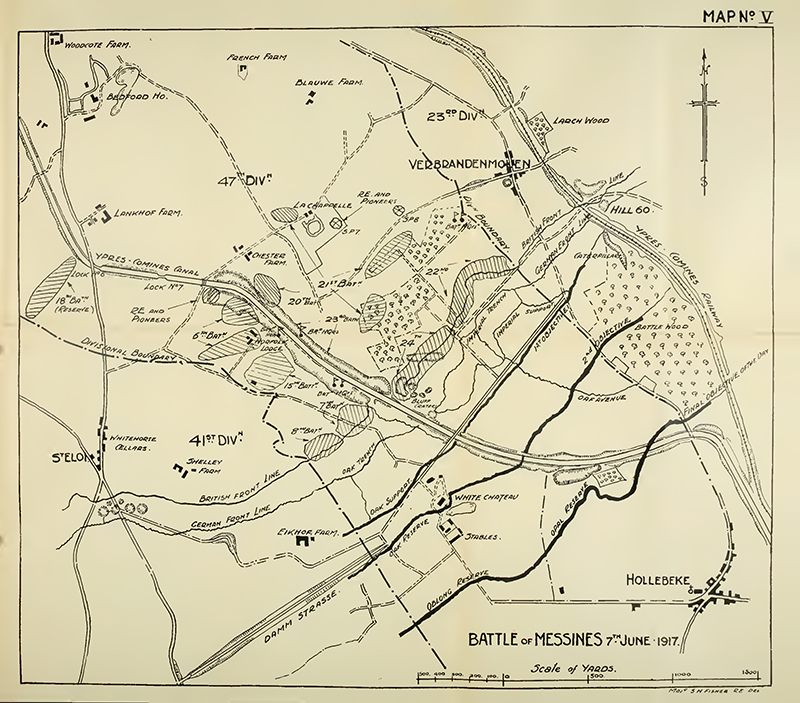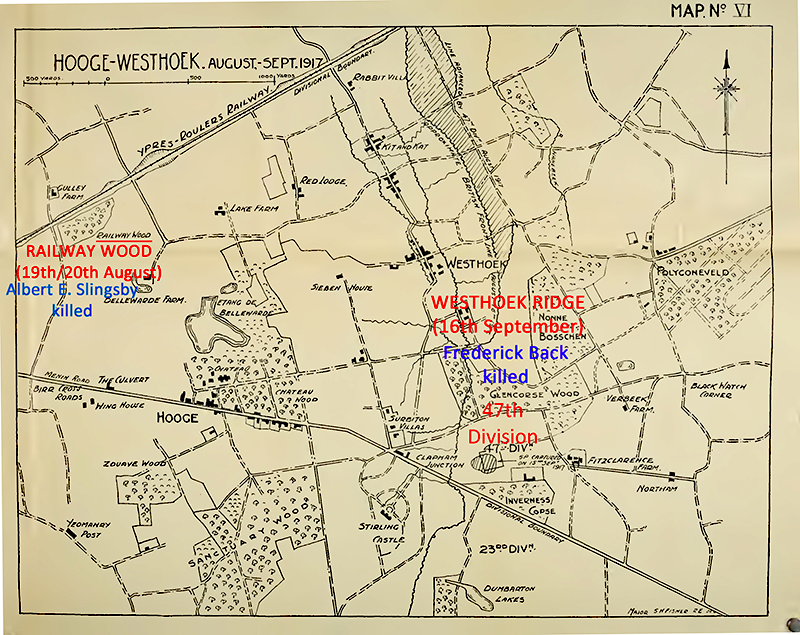First World War Project
Albert Edward SLINGSBY (of Newnham)
b. (chr) 17th June 1894 Private, Service Number 613113 |
_Memorial.png)
Albert's father, William, was a native of Aldington/Ashford, whose work took him northwards via farm labouring at Dymchurch (near Canterbury) and later a lodging labourer in Upchurch. He then became a beer house keeper at Wychling, before becoming a Farm Bailiff at Maitlands Farm, Wychling. At the end of 1884, William married Ospringe-born Emily Moon (registered in Faversham) who bore 8 children, of which six survived infancy - Frances, Annie, Albert Edward, Lizzie, Rosa and Walter.
In the second quarter of 1916, Albert married Anne Caroline Godden at Faversham.
From the very few papers to survive for Albert, it appears that he first enlisted in December 1915 (based on his War Gratuity). into the 4th (Reserve) Battalion The Buffs (East Kent Regiment) – Reg. No. 4328. Albert then took one of two avenues to receive his training. He may have remained in The Buffs or he may have moved straight into the London Regiment Training Battalion with the Reg. No. 7169 (potentially the 3/19th London (Reserve) Battalion). The fact that he has two numbers in the London Regiment (7169 & 613113) argues for his training in one of their training Battalions.
Assuming he trained for around six months, he appears to have been taken out of the Reserve and posted to the 1st/19th (County of London) Battalion (St. Pancras) in June 1916. This is corroborated in some measure by his marriage, in June 1916, to Newnham-born Anne Caroline Godden. A year later, after Albert's death, Caroline married again to become Mrs Arnott and emigrating to 16 Dora Street, Mayfield, Newcastle, New South Wales, Australia.
1/19th London Battalion were part of the 141st (5th London) Brigade, in the 47th (2nd London) Division. The 47th (2nd London) Division included the 1/18th Battalion, in which Reuben Reader (from Teynham) served - he died five days later.
From 12th June, Albert's Battalion experienced a month of relative calm in the Agnes Sector, except when the 19th Battalion led a raid near Bully Crater preceded by a discharge of 1,300 cylinders of gas. Gas was by this time a common occurrence for both sides.
Albert fought on The Somme, his Battalion taking part in the Battle of Flers-Courcelette, the Capture of High Wood, the Battle of Transloy Ridge, the capture of Eacourt L'Abbaye that began on 1st October supported by tanks and finally the attacks on the Butte De Warlencourt. The Germans relinquished this feature as part of their fall-back to the prepared lines of hardened defence (Hindenberg Line).
On 5th June 1917, in the summer heat, the Battalion was relieved out of trenches by the 22nd London Regiment back to Devonshire Camp for bathing and on 6th June they moved to the First Battle Position near Swan Chateau where they suffered significant explosive and gas shelling that delayed the Battalion until 2.00 a.m. They were ready to mount the Battle of Messines at 3.10 a.m., which opened with the ignition of a large number of mines coincident with a massive artillery barrage. The 19th Battalion was held in Reserve to the 140th and 142nd Brigades. At 5 a.m., the 19th Battalion progressed up from Swan Chateau to the Bluff Tunnels in artillery formation. The front gained was held in spite of concentrated artillery fire on their positions. At the end of 7th June, Albert's Battalion relieved the 21st and 22nd Battalions.

With the attack secured, the 19th Battalion were relieved back to billets in the nearby village of Blaringhem for recuperation and training to the end of June. The Battalion moved again to Alberta Camp, Reninghelst before going back into the "Ravine" Trenches to undertake improvement works, also providing working parties for the forward area before the whole Battalion went into the front at Battle Wood. There was a steady flow of casualties, mostly wounded during the period up to 15th July when they were relieved back to Alberta Camp, Reninghelst. Several days of recuperation, including Sports. On 31st July, the Battalion had relocated to Ridge Wood into bivouacs, ready to receive ammunition from the Brigade Dump and replenish their drinking water. The 141st Infantry Brigade, of which Albert's Battalion was a part, was put in a state of readiness, in Reserve to the 41st Division.
Expecting to be relieved back to Reninghelst Area on 5th August, that move was cancelled and they were on two hours notice. However, they weren't called on and were able to move to Alberta Camp, Reninghelst the next day.
Circumstances of the death of Albert Edward Slingsby
On 8th August, the Battalion Transport left Albert Camp, Reninghelst by road to SETQUES and the Battalion marched to ABEELE STATION, entrained for ST. OMER, where they then marched to SETQUES billets without incident. On 11th August, the Battalion marched from billets to Army School Range at CORMETTE. Firing practice continued through to 14th August. The next day was allocated to taking baths in ST. OMER.
On 16th August, the Battalion returned to firing practice but were ready to move at short notice. 2nd Line Transport left SETQUES for NOORDPEENE in the evening. The next day (17th), the Battalion entrained at WIZERNES and detrained at Ouberdom Siding, and marched into Halifax Camp before going to Cavalry Barracks, YPRES, to relieve 8th Battalion South Lancs Regiment.
The Battalion War Diary described the circumstances in the Front Line and risks associated with relief operations when, usually, there were higher casualty figures. Note: Frederick Back died close by.
18th August: "Moved to RAILWAY WOOD near HOOGE - Battalion billeted in Tunnels and in Reserve to the Brigade. Casualties: 2 other ranks wounded.
19th August: Battalion in reserve at Railway Wood. Casualties: 2 other ranks wounded.
20th August: Battalion in reserve. Casualties: 3 other ranks wounded.
21st August: Battalion relieved 17th Battalion London Regiment south of Ypres-Roulers Railway. Casualties: 5 killed, 8 wounded, 2 missing, 2 S.I.W. [Self Inflicted Wound].
22nd August: At 4.45 am, "D" Company cooperated in an attack with the 15th Division and advanced our line about 150 yards. Severe opposition was met and majority of casualties caused by enemy machine guns firing from Concrete Dugouts. Casualties: 1 Officer wounded, 1 officer missing, 16 other ranks killed, 2 other ranks died of wounds, 35 other ranks wounded, 4 other ranks missing, 1 shell shock.
23rd August: Operation Orders received for relief on August 24th by 22nd Battalion London Regiment. Casualties: 1 killed, 8 wounded, 1 shell shock.
24th August: Battalion relieved by 22nd Battalion commencing at 10.15pm. After relief Battalion moved to Billets in Ypres. Casualties: 4 wounded."
Of this waterlogged period at the Front Line, "The History of the 47th (London) Division" (edited by Alan H. Maude) reveals:
"On August 16th the Division was transferred from Tenth Corps, Second Army, to Eleventh Corps, Fifth Army. This change showed us that before long we should probably be called upon to go into the line somewhere east of Ypres to take part in the Fifth Army offensive, which was still in progress, and gradually gaining ground over the waterlogged and desolate country in the neighbourhood of the Westhoek Ridge, whose acquaintance we were shortly to make.
On August 17th the Division, less Divisional Artillery, 140th Infantry Brigade, and 4th R.W.F., moved up by tactical train to the 2nd Corps area, preparatory to relieving the 8th Division on the night of August 18th-19th, in the front-line defences between the Westhoek-Zonnebeke road and the Ypres-Roulers railway.
During the winter we had all seen much of Ypres on our way up to the trenches, but we were now to become more intimately acquainted with it and its wonderful ramparts, the Menin Gate, Hell Fire Corner, and many other well-known landmarks. We were also to get to know the sensation of marching up the Menin Road on a pouring wet night, with its mass of transport, its mud, and the enemy's shells trying to prevent any horse, wagon,, or man arriving at his destination that night.
Gas masks were in constant use, and everybody became an expert in the rapid adjustment of these valuable items of our kit. The journey through Ypres, too, was always a trying time for troops moving up the line, as frequent halts were necessary in the narrow street ways, and it was very seldom that some part of the poor, battered town was not being shelled. But the traffic control was most efficient, and the Military Police seemed always to be standing at their allotted corners, no matter how hot the shelling was, ready to help with all kinds of information, military and otherwise.
We found our old friends of Loos, the 15th (Highland) Division, on our left when we went into the line and on August 15th this Division attacked with some success, and our front-line troops pushed forward posts in conjunction with their advance to the line of the Hanebeek, a small stream, which our shelling had turned into an absolute morass.
The rain was our chief enemy in these trying days, when to get off the duckboard tracks often meant sinking up to one's knees in the sodden ground. It seemed to rain every day and every night, and on the night of August 26th there was a perfect deluge, which filled every shell-hole – the ground seemed to consist of little else – with water up to the brim, and made the roads and tracks more difficult than ever.
Offensive operations under these climatic conditions were extremely trying, the deep dugouts often being inches deep in water, and anybody in possession of a concrete German Pill-box was much to be envied. Derelict Tanks were to be seen in all direction, and generally the state of the forward areas was anything but pleasant."
Medal Records shows that Albert Edward Slingsby was posthumously awarded the British War and Victory Medals. [See Appendix 1]


 World War 1 Pages
World War 1 Pages